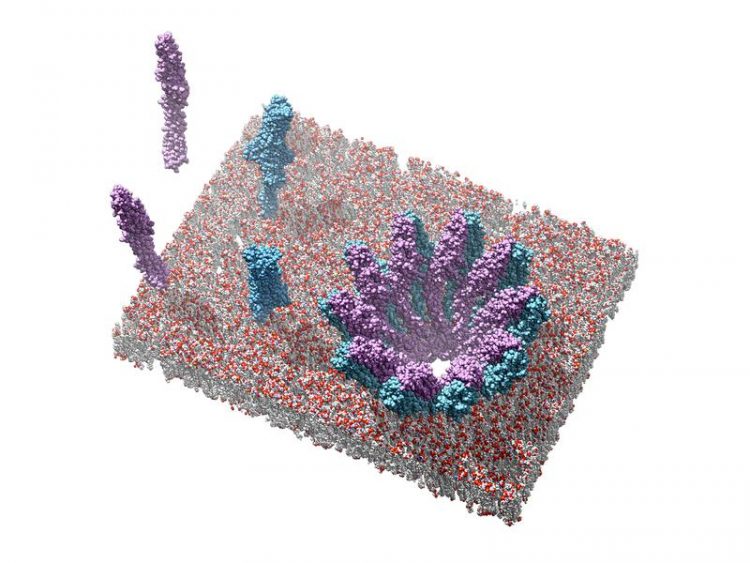Research team uncovers mechanism of action for a class of bacterial toxins: Deadly duet

Single subunits of YaxA (blue) and YaxB (purple) and a pore built up from these subunits. Image: Bastian Bräuning / TUM
Pore-forming toxins are bacterial poisons that destroy cells by creating holes in the cell membranes. Many bacterial pathogens produce such toxins, including, for example, some strains of the intestinal bacterium Escherichia coli as well as Yersinia enterolitica, a pathogen related to the plague. With the help of their toxins they attack all kinds of organisms – from plants to insects, and even humans.
Scientists all over the world are trying to understand just how these toxins produce the fatal holes in cell membranes in the hope of one day inhibiting the pathogenic, pore-forming poisons.
Now an interdisciplinary team from the Technical University of Munich has managed to elucidate the mode of action of a subspecies of the toxin class in which two components interact to develop the deadly effect.
Two partners with lethal impact
Combining crystallographic and cryo-electron microscopy methods, Bastian Bräuning and Professor Michael Groll from the Department of Biochemistry, in collaboration with Eva Bertosin and Professor Hendrik Dietz from the Department of Experimental Biophysics, managed to shed light upon the precise molecular structures of the soluble individual components, as well as the pore complex.
“We determined that only one of the two components is able to bind to the membrane. In a second step it recruits the other component and the base domains of two proteins together form the basic pore unit,” explains Bastian Bräuning. “This is a new kind of mechanism from which we can obtain much useful insight.”
The structure of the resulting hole in the cell membrane resembles a crown, whose teeth comprise 40 subunits of the two interacting partners.
One mechanism – myriad potential applications
The team of researchers lead by Bräuning and Groll investigated the interaction of the two partner proteins in the toxins of Yersinia enterolitica and Photorhabdus luminescens, a bacterium that lives in nematodes: together, they attack susceptible insect hosts. The latter is thus interesting as an insecticide.
The new insight moves the development of substances that inhibit the interaction of the two components, and thus prevent the formation of pores, into the realm of the conceivable.
“Our combination of crystallography and cryo-electron microscopy was key to understanding the necessity of the two-component construction of the toxin from a biochemical perspective,” explains Professor Michael Groll. “This insight will also help us understand more complex variants in the future, for example those in which three components work together.”
Publication:
Bastian Bräuning, Eva Bertosin, Florian Praetorius, Christian Ihling, Alexandra Schatt, Agnes Adler, Klaus Richter, Andrea Sinz, Hendrik Dietz and Michael Groll
Structure and mechanism of the two-component α-helical pore-forming toxin YaxAB
Nature Communications, vol. 9, 1806 (2018) – DOI: 10.1038/s41467-018-04139-2
Link: https://www.nature.com/articles/s41467-018-04139-2
Further information:
The work is the result of close a cooperation between the professors of Biochemistry and Biophysics at the Technical University of Munich. Both working groups are part of the Cluster of Excellence Center for Integrated Protein Science Munich (CIPSM). The results were validated by the Department of Pharmaceutical Chemistry and Bioanalytics at the Institute of Pharmacy of the Martin-Luther University Halle-Wittenberg. The X-ray structure data were collected at the synchrotron light source of the Paul Scherrer Institute (Villigen, Switzerland).
Contact:
Prof. Michael Groll
Technical University of Munich
Chair of Biochemistry
Tel.: +49 89 289 13361
michael.groll@tum.de
https://www.tum.de/nc/en/about-tum/news/press-releases/detail/article/34629/ Link to the press release
Media Contact
More Information:
http://www.tum.deAll latest news from the category: Life Sciences and Chemistry
Articles and reports from the Life Sciences and chemistry area deal with applied and basic research into modern biology, chemistry and human medicine.
Valuable information can be found on a range of life sciences fields including bacteriology, biochemistry, bionics, bioinformatics, biophysics, biotechnology, genetics, geobotany, human biology, marine biology, microbiology, molecular biology, cellular biology, zoology, bioinorganic chemistry, microchemistry and environmental chemistry.
Newest articles

Bringing bio-inspired robots to life
Nebraska researcher Eric Markvicka gets NSF CAREER Award to pursue manufacture of novel materials for soft robotics and stretchable electronics. Engineers are increasingly eager to develop robots that mimic the…

Bella moths use poison to attract mates
Scientists are closer to finding out how. Pyrrolizidine alkaloids are as bitter and toxic as they are hard to pronounce. They’re produced by several different types of plants and are…

AI tool creates ‘synthetic’ images of cells
…for enhanced microscopy analysis. Observing individual cells through microscopes can reveal a range of important cell biological phenomena that frequently play a role in human diseases, but the process of…





















